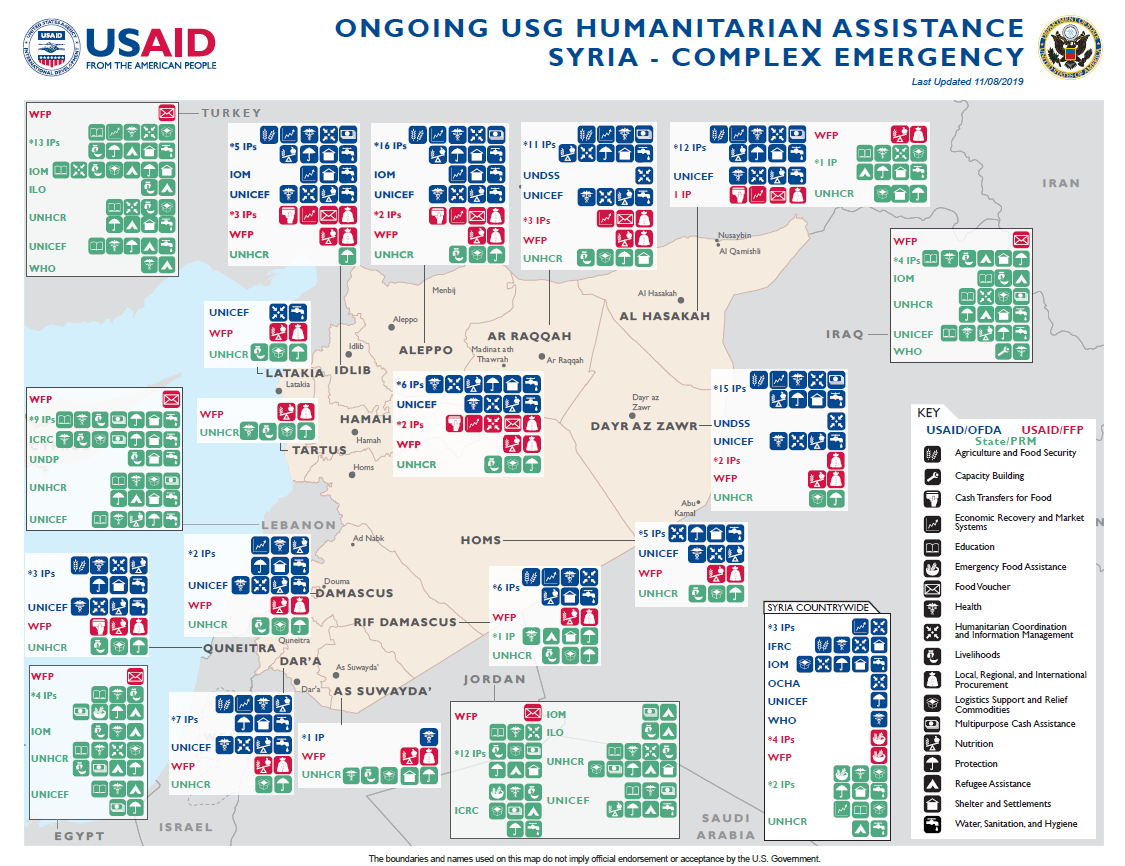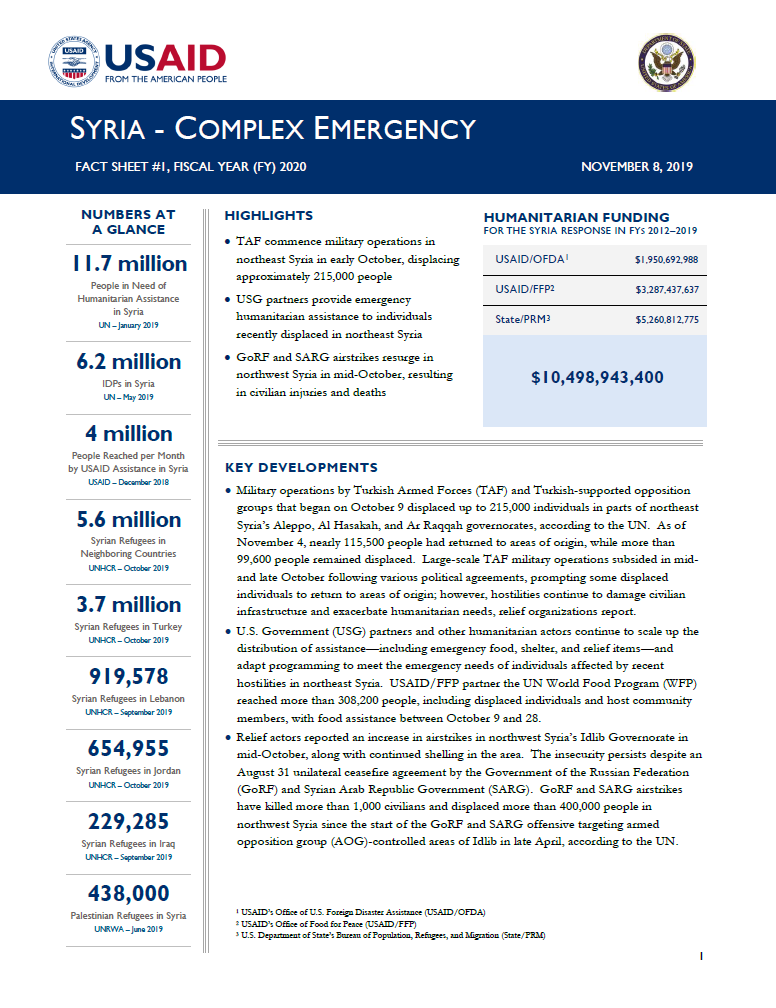- What We Do
- Agriculture and Food Security
- Democracy, Human Rights and Governance
- Economic Growth and Trade
- Education
- Environment and Global Climate Change
- Gender Equality and Women's Empowerment
- Global Health
- Humanitarian Assistance
- Transformation at USAID
- Water and Sanitation
- Working in Crises and Conflict
- U.S. Global Development Lab
Speeches Shim
November 08, 2019
Highlights
TAF commence military operations in northeast Syria in early October, displacing approximately 215,000 people
USG partners provide emergency humanitarian assistance to individuals recently displaced in northeast Syria
GoRF and SARG airstrikes resurge in northwest Syria in mid-October, resulting in civilian injuries and deaths
Key Developments
Military operations by Turkish Armed Forces (TAF) and Turkish-supported opposition groups that began on October 9 displaced up to 215,000 individuals in parts of northeast Syria’s Aleppo, Al Hasakah, and Ar Raqqah governorates, according to the UN. As of November 4, nearly 115,500 people had returned to areas of origin, while more than 99,600 people remained displaced. Large-scale TAF military operations subsided in mid- and late October following various political agreements, prompting some displaced individuals to return to areas of origin; however, hostilities continue to damage civilian infrastructure and exacerbate humanitarian needs, relief organizations report.
U.S. Government (USG) partners and other humanitarian actors continue to scale up the distribution of assistance—including emergency food, shelter, and relief items—and adapt programming to meet the emergency needs of individuals affected by recent hostilities in northeast Syria. USAID/FFP partner the UN World Food Program (WFP) reached more than 308,200 people, including displaced individuals and host community members, with food assistance between October 9 and 28.
Relief actors reported an increase in airstrikes in northwest Syria’s Idlib Governorate in mid-October, along with continued shelling in the area. The insecurity persists despite an August 31 unilateral ceasefire agreement by the Government of the Russian Federation (GoRF) and Syrian Arab Republic Government (SARG). GoRF and SARG airstrikes have killed more than 1,000 civilians and displaced more than 400,000 people in northwest Syria since the start of the GoRF and SARG offensive targeting armed opposition group (AOG)-controlled areas of Idlib in late April, according to the UN.
Syria Complex Emergency - Map #1 FY20 ![]() (pdf - 483k)
(pdf - 483k)
Numbers At A Glance
11.7 million
6.2 million
4 million
5.6 million
3.7 million
919,578
654,955
229,285
438,000
Humanitarian Funding
To Syria Humanitarian Response
FY 2012 - FY 2019
| USAID/OFDA | $1,950,692,988 |
| USAID/FFP | $3,287,437,637 |
| State/PRM | $5,260,812,775 |
| TOTAL | $10,498,943,400 |
Syria Complex Emergency - Fact Sheet #1 FY20 ![]() (pdf - 339k)
(pdf - 339k)
INSECURITY AND DISPLACEMENT
Northeast Syria
As of November 4, more than 99,600 people displaced from and within Aleppo, Al Hasakah, and Ar Raqqah since October 9 remained displaced, according to the UN. Many recently displaced people have sought shelter with host communities or in informal settlements or collective centers across Dayr az Zawr, Al Hasakah, and Ar Raqqah governorates; as of November 4, newly displaced persons were sheltering in 88 collective centers in Al Hasakah alone. Approximately 115,500 people have returned to areas of origin, including approximately 105,400 people to Al Hasakah and Ar Raqqah, due to relatively improved security conditions following a series of political agreements in mid-October.
Despite recent political agreements, hostilities continue near Al Hasakah’s Ras al-Ain city and along parts of the Aleppo–Lattakia (M4) highway—a critical transport route for humanitarian supplies stretching across northern Syria from Lattakia Governorate to the Syria–Iraq border—between Aleppo’s Ayn al-Arab city, also known as Kobane, and Ar Raqqah’s Ein Issa city, according to the UN. On November 2, unknown actors detonated a car bomb in Tell Abyad, killing at least 13 civilians and injuring 20 others.
USG partners and other relief actors continue to scale up humanitarian assistance and adjust programming to meet the needs of internally displaced persons (IDPs) adversely impacted in northeast Syria. USAID/FFP and USAID/OFDA partners continue to provide bread and ready-to-eat (RTE) and monthly food rations, medical services, water trucking, multipurpose cash transfers, shelter materials, and relief items to IDPs. In addition, many households hosting recently displaced individuals already rely on humanitarian support to meet basic needs and will likely require increased levels of support during the coming weeks.
The Alouk water station, located near Ras al-Ain, is currently non-operational due to shelling that damaged the facility’s power lines on October 29. Technical staff, including State/PRM implementing partners, previously conducted repairs to the water station on October 19 after it sustained damage on October 10. Alouk is the only water station with the capacity to support an estimated 460,000 people in Al Hasakah city, Tell Tamer city, and surrounding areas, as well as nearby Areesheh and Al Hol camps.
More than 14,300 Syrians had crossed from northeast Syria into Iraq as of November 6, according to the International Organization for Migration (IOM) Displacement Tracking Matrix, which is funded by State/PRM. To date, State/PRM partner the Office of the UN High Commissioner for Refugees (UNHCR) has provided protection services for more than 2,400 unaccompanied children and other vulnerable populations at border reception centers and distributed hygiene kits and shelter supplies at the Al Sahela and Al Walid border crossings. In mid-October, UNHCR reopened Bardarash and Gawilan camps in Iraq’s Ninewa Governorate to accommodate new arrivals. In addition, the UN agency is partnering with local authorities to transport refugees from the Syria–Iraq border to Bardarash and Gawilan, as well as provide food, shelter and winter-related relief items and health and protection services to recent arrivals. USAID/FFP partner WFP is also assisting new arrivals in Bardarash and Gawilan with emergency food distributions.
Northwest Syria
Airstrikes on AOG-controlled areas resumed in southern and western Idlib in mid-October, despite the announcement of a GoRF–SARG unilateral ceasefire in the governorate on August 31, according to the UN. Shelling has also continued in several areas of northwest Syria through early November. Airstrikes killed three civilians and injured 15 civilians in Idlib’s Jisr al-Shughur city on November 4, while artillery shelling struck a health facility compound in Ma’arrat al-Numan sub-district on October 3, injuring seven people, according to non-governmental organizations (NGOs) operating in the area. Prior to the incident on the health compound, health workers at the facility provided essential nutrition and vaccination services to an average of 200 people per day and conducted approximately 5,900 outpatient consultations per month. Overall, GoRF and SARG airstrikes and shelling have resulted in more than 1,000 deaths and the displacement of more than 400,000 people in northwest Syria since the start of the GoRF–SARG offensive in late April, according to the UN.
FOOD SECURITY AND NUTRITION
From October 9 to 28, USAID/FFP partner WFP reached more than 308,200 people in northeast Syria, including recently displaced individuals and host community members, with food assistance. The assistance included general food assistance sufficient for more than 204,000 people for one month and RTE rations, which cover food needs for a period of five days, for nearly 104,000 people. Additionally, WFP has provided RTE rations for 11,750 Syrian refugees who recently arrived in northern Iraq.
As of October 31, WFP had delivered general food assistance—through in-country and cross-border deliveries from Turkey—sufficient to meet the needs of approximately 4 million people in Syria, representing 97 percent of the UN agency’s monthly target. WFP delivered the assistance despite a shortage of fuel supplies and fuel price increases in northeast Syria since the start of TAF military operations, which have disrupted supply lines for the transportation of fuel in northeast Syria. NGOs anticipate fuel prices will also continue to increase should the conflict in northeast Syria continue, which could create an additional financial burden on households and increase costs for relief agencies providing assistance in the area. Additionally, flour and bread prices in areas of northwest Syria have increased as a result of the rising fuel prices.
In response to critical needs resulting from the conflict in northeast Syria, a USAID/OFDA partner established a blood bank and trauma treatment center in western Al Hasakah’s Tell Tamer Hospital in mid-October to serve injured individuals. Additionally, the NGO delivered medical consumables to Al Hasakah’s Amuda town to meet short-term needs and provided supplies, equipment, and staff to Hasakah National Hospital. On October 17, a mobile medical unit (MMU) made a preparatory visit to three school locations in Al Hasakah. USAID/OFDA also continues to support MMUs operating in Dayr az Zawr, which have been able to continue regular service delivery.
RELIEF COMMODITIES AND WATER, SANITATION, AND HYGIENE
USAID/OFDA partners continue to supply water to populations affected by disruptions to operations of the Alouk water station and have installed more than 150 water tanks for communities and collective centers in the area. Relief actors are also advocating access for technical staff to complete repairs and maintain presence at the water station to return the facility to full capacity, though access is constrained due to ongoing hostilities in the area.
Separately, a USAID/OFDA partner has distributed new arrival kits and hygiene kits to nearly 700 households displaced in Ar Raqqah since early October. Another NGO has distributed more than 5,600 hygiene kits, nearly 3,500 RTE food rations, and approximately 2,500 water containers to benefit 50,700 individuals in Al Hasakah, Mabada, and Tell Tamer cities.
Since October 9, State/PRM partner UNHCR has provided approximately 126,000 individuals in camps and collective shelters across northeast Syria with essential winter-related relief items, such as thermal blankets and winter clothing. The UNHCR distributions have reached nearly 60,000 people in Al Hasakah’s Areesheh, Ein Issa, Al Hol, Mahmoudli, and Roj camps.
In October, a USAID/OFDA partner began procurement of winter relief item kits—including blankets, heaters, and water containers—to respond to the winterization needs of an estimated 14,000 households across northwest Syria. The partner also commenced distribution of multipurpose cash assistance and vouchers to populations in need, and plans to reach more than 16,000 households with assistance over the next several months.
PROTECTION
State/PRM partner UNHCR recently completed protection needs assessments in nearly 30 collective shelters across northeast Syria. As of November 2, UNHCR had reached more than 8,700 individuals with protection services in the area, including case management, gender-based violence (GBV) prevention sessions, and psychosocial support (PSS) services.
Between January and August, humanitarian agencies, including USAID/OFDA and State/PRM partners, conducted awareness campaigns regarding child protection issues for more than 701,000 people and implemented structured child protection programs for nearly 553,000 children across Syria, according to the Protection Cluster—the coordinating body for humanitarian protection activities, comprising UN agencies, NGOs, and other stakeholders. Relief agencies are also addressing the specific needs of adolescents; in Idlib, one USAID/OFDA partner continues to provide PSS activities for children and adolescents, facilitate youth groups and life skills sessions, and support a youth center. Another USAID/OFDA partner conducted awareness-raising activities on protection risks for nearly 1,300 men and boys in Idlib during August, while a third partner in the area continues to provide legal advice and information to help people navigate the civil documentation process.
PUBLIC DONATION INFORMATION
The most effective way people can assist relief efforts is by making cash contributions to humanitarian organizations that are conducting relief operations. A list of humanitarian organizations that are accepting cash donations for disaster responses around the world can be found at www.usaid.gov/crisis/syria.
The USG encourages cash donations because they allow aid professionals to procure the exact items needed (often in the affected region); reduce the burden on scarce resources (such as transportation routes, staff time, and warehouse space); can be transferred very quickly and without transportation costs; support the economy of the disaster-stricken region; and ensure culturally, dietary, and environmentally appropriate assistance.



Comment
Make a general inquiry or suggest an improvement.